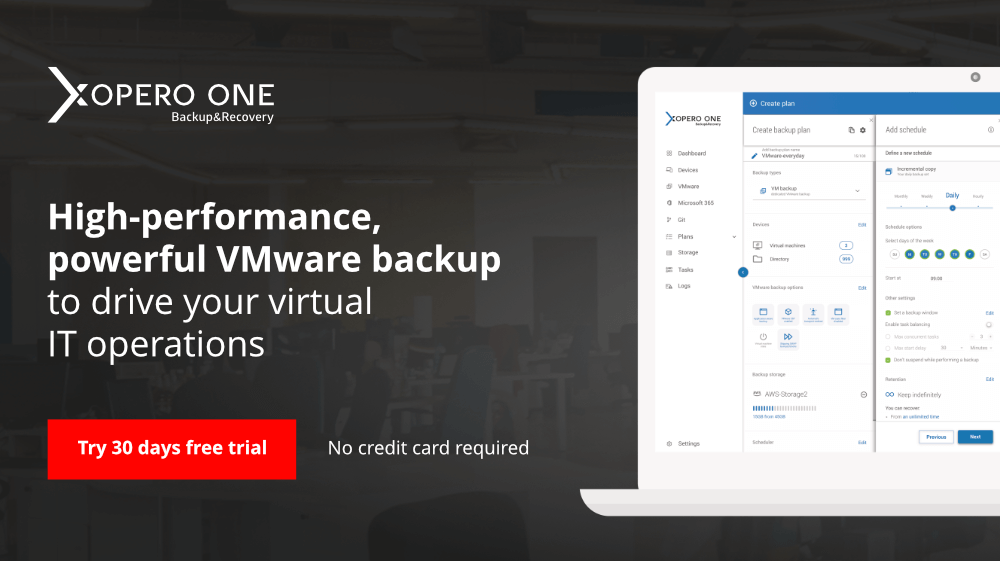On the pages of our blog, we have already discussed virtualization tools from VMware, but it must be remembered that this is not the only solution of this type on the market. Microsoft has been heavily involved in virtualization since 2008 and is developing its project codenamed Viridian. Let’s check and compare how both companies approached converting virtual machines between competing virtualizers.
The IT world is full of curiosities
Microsoft initially approached virtualization as most corporations are used to, and purchased a desktop virtualization solution from Connectix called Virtual PC. In the following years, the company from Redmond used and developed this application under the name Virtual PC, and after transformation, Microsoft Virtual PC. This is how the Viridian codename project, now known as Hyper-V, was born. This entire journey by MS to have a leading virtualization solution continues today since the purchase of Virtual PC in 2003.
It must be admitted that drawing your plans with the assumption that in the first years, they bring only losses is also characteristic for a corporation. This is, of course, aimed for future profits, and sometimes also it brings huge benefits in the form of Hyper-V, which is a comprehensive solution from MS for virtualization. We must admit that the path for MS to the native hypervisor wasn’t short, but thanks to this, we have a solution that has been implemented for years in the code of Windows operating systems. This, of course, ensures excellent compatibility, stability, and intuitive operation. You also have to admit that MS approached virtualization from the very beginning as a project that would be part of their operating systems, not its external application or server. Thanks to this, it can be said that both Microsoft Virtual PC and Hyper-V are currently free.
Rumors have it that Hyper-V was a project that gave birth to a large part of the current cloud known as Azure. Hyper-V is currently in version 3 and allows you to virtualize all major operating systems except solutions from Apple. This is, of course, mainly thanks to Apple politics. As a representative of the native Hypervisor, we can create virtual networks, switches, devices, etc. Of course, we do all this in an isolated environment that is managed by Hyper-V. Additionally, as in the case of VMware, we have the option of saving the state of a given virtual machine. Admittedly, this process is quite different from VMware snapshots, but that’s a topic for a different blog post.
However, Hyper-V is quite young on the hypervisor market compared to the vSphere solution from VMware, and thus we will not always be able to bet on Hyper-V. Later in this post, we will present both companies’ solutions for converting machines to virtual.
I do not know if any of you still remember such an operating system as NetWare Novell 4.11, but this is a perfect example of the fact that the virtualization process is not always as simple as it seems. To virtualize Novell, it is not enough to turn on the latest conversion application from one of the vendors and click convert. NetWare introduced and used its own IPX protocol for years. In such cases, VMware shows its great advantage. The company, along with its ESX, which is now known as ESXi, has been on the market since 2001. To convert the already mentioned Novell 4.11 to Hyper-V, first, the physical machine must be virtualized to ESXi using the converting application. Then it can be exported or further converted from ESXi. This case is an exception, but you have to remember that choosing the path when converting is often crucial. Xopero presents its solution to make this process predictable, simple, and transparent. However, the most important thing during any similar process is having a backup of the machine, and Xopero ONE for VMware backup will help you in this too!
Convert VMware to Hyper-V – converting solutions
It would seem that there are several paths for moving, virtualizing, converting, and importing machines and that it is up to us which one to choose. For example, can we first export the virtual machine, then use the conversion application for a given environment to transfer it to the target infrastructure? We can do that to VMware infrastructure, but what with Hyper-V?
VMware I offer my clients an application called VMware vCenter Converter, and it is a really recommendable application for infrastructure based on vSphere. It is safe to say that this is a holistic approach for VMware, which means that we will be able to convert multiple machines at once, take snapshots, clones, etc. Of course, we will be able to convert machines from Hyper-V to a virtual infrastructure based on VMware solutions, but what if we want to convert a virtual machine from VMware to Hyper-V?
Microsoft has taken a different approach here. Since Hyper-V is so well implemented in the operating system itself, this is where the System itself comes to our aid, right? Unfortunately, we don’t have many options here. MS indeed offered a GUI tool using PowerShell to convert machines called Microsoft Virtual Machine Converter. Still, now the tool has the status of discontinued, and all links to its download from the Redmond giant’s website have been removed. Microsoft offers its solution called System Center Virtual Machine Manager to manage the entire Hyper-V infrastructure, including a tool (Convert Virtual Machine) for converting, but it is a paid solution. All this leads to one conclusion that there is currently no free solution supported by the manufacturer Hyper-V.


